
Original Link: https://www.anandtech.com/show/2855
NVIDIA’s GeForce GT 220: 40nm and DX10.1 for the Low-End
by Ryan Smith on October 12, 2009 6:00 AM EST- Posted in
- GPUs
There are some things you just don’t talk about among polite company. Politics, money, and apparently OEM-only GPUs. Back in July NVIDIA launched their first 40nm GPUs, and their first GPUs featuring DX10.1 support; these were the GeForce GT 220 and G 210. And if you blinked, you probably missed it. As OEM-only parts, these went into the OEM channel without any fanfare or pageantry.
Today that changes. NVIDIA is moving the GT 220 and G 210 from OEM-only sales to retail, which means NVIDIA’s retail vendors can finally get in on the act and begin selling cards. Today we are looking at one of the first of those cards, the Palit GT 220 Sonic Edition.
| Form Factor | 9600GT | 9600GSO | GT 220 (GDDR3) | 9500GT | G 210 (DDR2) |
| Stream Processors | 64 | 48 | 48 | 32 | 16 |
| Texture Address / Filtering | 32 / 32 | 24 / 24 | 16 / 16 | 16 / 16 | 16 / 16 |
| ROPs | 16 | 16 | 8 | 8 | 8 |
| Core Clock | 650MHz | 600MHz | 625MHz | 550MHz | 675MHz |
| Shader Clock | 1625MHz | 1500MHz | 1360MHz | 1400MHz | 1450MHz |
| Memory Clock | 900MHz | 900MHz | 900MHz | 400MHz |
400MHz |
| Memory Bus Width | 256-bit | 128-bit | 128-bit | 128-bit | 64-bit |
| Frame Buffer | 512MB | 512MB | 512MB | 512MB | 512MB |
| Transistor Count | 505M | 505M | 486M | 314M | 260M |
| Manufacturing Process | TSMC 55nm | TSMC 55nm | TSMC 40nm | TSMC 55nm | TSMC 40nm |
| Price Point | $69-$85 | $40-$60 | $69-$79 | $45-$60 | $40-$50 |
GT 220 and G 210 are based on the GT216 and GT218 cores respectively (anyone confused yet?) which are the first and so far only 40nm members of NVIDIA’s GT200 family. These are specifically designed as low-end cards, with 48 SPs on the GT 220, and 16 SPs on the G 210. The GT 220 is designed to sit between the 9500GT and 9600GT in performance, making its closest competitor the 48SP 9600GSO. Meanwhile the G 210 is the replacement for the 9400GT.
We will see multiple configurations for each card, as NVIDIA handles low-end parts somewhat looser than they do the high-end parts. GT 220 will come with DDR2, DDR3, or GDDR3 memory on a 128bit bus, with 512MB or 1GB of it. So the memory bandwidth of these cards is going to vary wildly; the DDR2 cards will be 400MHz and the GDDR3 cards may go as high as 1012MHz according to NVIDIA’s specs. G 210 meanwhile will be DDR2 and DDR3 only, again going up to 1GB. With a 64bit memory bus, it will have half the memory bandwidth of GT 220.
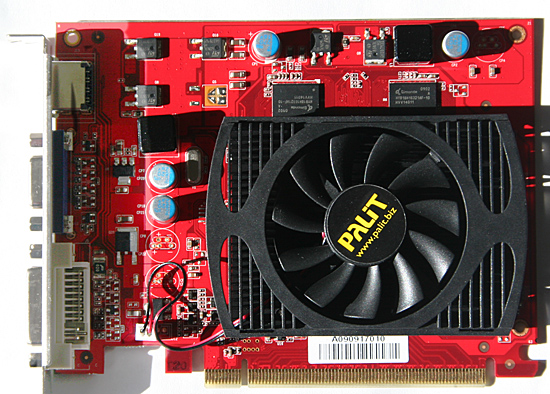
The GPU configurations will vary too, but not as wildly. NVIDIA’s official specs call for a 625MHz core clock and a 1360MHz shader clock. We’ve seen a number of cards with a higher core clock, and a card with a lower shader clock. Based on the card we have, we’re going to consider 635Mhz/1360Mhz stock for the GPU, and 900MHz stock for GDDR3, and test accordingly.
The transistor count for the GT218 die comes out to 260M, and for GT216 it’s 486M. NVIDIA would not disclose the die size to us, but having disassembled our GT 220, we estimate it to be around 100mm2. One thing we do know for sure is that along with the small die, NVIDIA has managed to knock down power consumption for the GT 220. At load the card will draw 58W, at idle it’s a tiny 7W. We don’t have the power data for the G 210, but it’s undoubtedly lower.
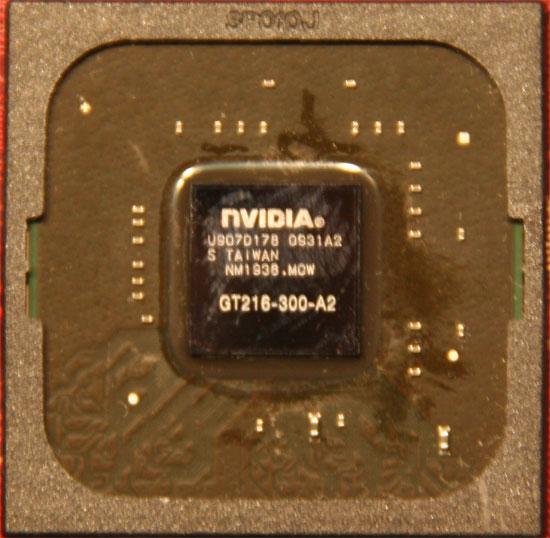
The prices on GT 220 cards are expected to range between $69 and $79, with the cards at the top end being those with the best RAM. This puts GT 220 in competition with AMD’s Radeon HD 4600 series, and NVIDIA’s own 9600GT. The G 210 will have an approximate price of $45, putting it in range of the Radeon HD 4300/4500 series, and NVIDIA’s 9500GT. The GT 220 in particular is in an odd spot: it’s supposed to underperform the equally priced (if not slightly cheaper) 9600GT. Meanwhile the G210 is supposed to underperform the 9500GT, which is also available for $45. So NVIDIA is already starting off on the wrong foot here.
Finally, availability should not be an issue. These cards have been shipping for months to OEMs, so the only thing that has really changed is that now some of them are going into the retail pool. It’s a hard launch and then some. Not that you’ll see NVIDIA celebrating; while the OEM-only launch was no-key, this launch is only low-key at best. NVIDIA didn’t send out any samples, and it wasn’t until a few days ago that we had the full technical data on these new cards.
We would like to thank Palit for providing us with a GT 220 card for today’s launch, supplying us with their GT 220 Sonic Edition.
DirectX 10.1 on an NVIDIA GPU?
Easily the most interesting thing about the GT 220 and G 210 is that they mark the introduction of DirectX 10.1 functionality on an NVIDIA GPU. It’s no secret that NVIDIA does not take a particular interest in DX10.1, and in fact even with this they still don’t. But for these new low-end parts, NVIDIA had some special problems: OEMs.
OEMs like spec sheets. They want parts that conform to certain features so that they can in turn use those features to sell the product to consumers. OEMs don’t want to sell a product with “only” DX10.0 support if their rivals are using DX10.1 parts. Which in turn means that at some point NVIDIA would need to add DX10.1 functionality, or risk losing out on lucrative OEM contracts.
This is compounded by the fact that while Fermi has bypassed DX10.1 entirely for the high-end, Fermi’s low-end offspring are still some time away. Meanwhile AMD will be shipping their low-end DX11 parts in the first half of next year.
So why do GT 220 and G 210 have DX10.1 functionality? To satisfy the OEMs, and that’s about it. NVIDIA’s focus is still on DX10 and DX11. DX10.1 functionality was easy to add to the GT200-derrived architecture (bear in mind that GT200 already had some DX10.1 functionality), and so it was done for the OEMs. We would also add that NVIDIA has also mentioned the desire to not be dinged by reviewers and forum-goers for lacking this feature, but we’re having a hard time buying the idea that NVIDIA cares about either of those nearly as much as they care about what the OEMs think when it comes to this class of parts.
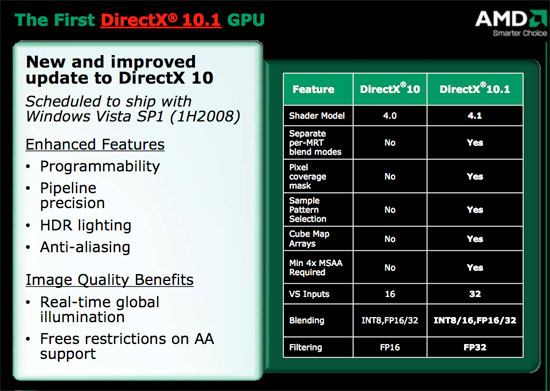
DX10.1 in a nutshell, as seen in our Radeon 3870 Review
At any rate, while we don’t normally benchmark with DX10.1 functionality enabled, we did so today to make sure DX10.1 was working as it should be. Below are our Battleforge results, using DX10 and DX10.1 with Very High SSAO enabled.
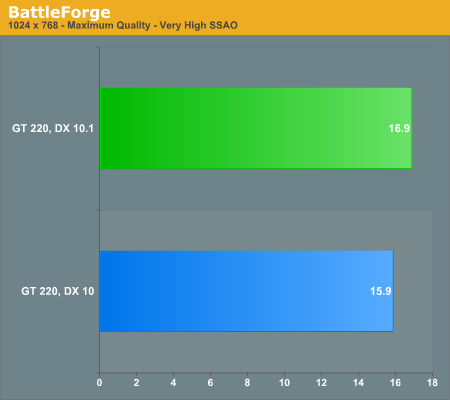
The ultimate proof that DX10.1 is a checkbox feature here is performance. Certainly DX10.1 is a faster way to implement certain effects, but running them in the first place still comes at a significant performance penalty. Hardware of this class is simply too slow to make meaningful use of the DX10.1 content that’s out there at this point.
A Better HTPC Card: MPEG-4 ASP Decoding & LPCM Audio
Along with the addition of DirectX 10.1 functionality, the latest members of NVIDIA’s GPU lineup have picked up a couple of new tricks specifically geared towards HTPC use.
The first of these is a newer video decoding engine. Officially NVIDIA is moving away from the VP* moniker, but for the time being we’re sticking to it as we don’t have a better way of easily differentiating the feature sets of various video decoding engines. NVIDIA’s vendors are calling this VP4, and so are we.
Successive VPs have focused on adding support for additional video formats. VP2 had full H.264 decoding, and VP3 (which never made it into a GTX 200 series part) added VC-1 decoding. For VP4, NVIDIA has added support for full decoding of MPEG-4 (Advanced) Simple Profile, better known as DivX or XviD. With this addition, NVIDIA can now offload the decoding of most of the MPEG formats – the only thing not supported is MPEG-1, which as the oldest codec is trivial to decode on a CPU anyhow.
To be frank, we’re a bit puzzled by this latest addition. By no means are we unhappy (we’ll always take more acceleration!), but MPEG-4 ASP isn’t particularly hard to decode. Even an underclocked Nehalem with only a single core (and no HT) enabled can handle HD-resolution MPEG-4 ASP with ease; never mind what even a low-end dual-core Pentium or Celeron can do. This would be a good match for the Atom, but those almost always use integrated graphics (and Ion isn’t slated to get VP4 any time soon). So while this addition is nice to have, it’s not the kind of game changer that adding H.264 and VC-1 were.
The unfortunate news here is that while the hardware is ready, the software is not, and this is something that caught us off-guard since these parts have been going to OEMs since July. NVIDIA has yet to enable MPEG-4 ASP acceleration in their drivers, and won’t be doing so until the release 195 drivers. So at this point we can’t even tell you how well this feature works. We’re not pleased with this, but we’re also not particularly broken up about it since as we just mentioned the cost of CPU decoding isn’t very much in the first place.
On a final note with video decoding, one of NVIDIA’s marketing pushes with this launch is touting the fact that they have been working with Adobe to bring video decode acceleration to Adobe Flash 10.1, and that the GT 220/G 210 series are well suited for this. This is going to be absolutely fantastic to have since Flash Video is a CPU-hog, but Flash 10.1 is still 6 months (or more) away from being released. More to the point, as far as we know this is being implemented via DXVA, which means everyone else will get acceleration too. And notably, this is only for H.264, as VP6 (the older Flash Video codec) is not supported in hardware on any card.
Moving on, the other new HTPC feature is that NVIDIA has finally stepped up their game with respect to HDMI audio on cards with discrete GPUs. Gone is the S/PDIF cable to connect a card to an audio codec, which means NVIDIA is no longer limited to 2-channel LPCM or 5.1 channel DD/DTS for audio. Now they are passing audio over the PCIe bus, which gives them the ability to support additional formats. 8 channel LPCM is in, as are the lossy formats DD+ and 6 channel AAC. However Dolby TrueHD and DTS Master Audio bitstreaming are not supported, so it’s not quite the perfect HTPC card. Lossless audio is possible through LPCM, but there won’t be any lossless audio bitstreaming.
Finally, we’re still waiting to see someone do a passive cooled design for the GT 220. The power usage is low enough that it should be possible with a dual-slot heatsink, but the only cards we’ve seen thus far are actively cooled single-slot solutions with the heatsink sticking out some.
Palit’s GT 220 Sonic Edition
As we mentioned in our introduction, for today’s launch we have a GT 220 graciously provided by Palit, in the form of their $79 GT 220 Sonic Edition. This card is ever so slightly factory overclocked, coming in at 650MHz for the core (a 4% overclock), a standard 1360MHz for the shaders, and 900MHz for its GDDR3 memory. As this is a GDDR3 card, it comes with 512MB of RAM.

As far as we know, this is as close to a reference cooler as you’re going to see for the GT 220, as we’ve seen this cooler on a couple other product brochures. It’s a rectangular single-slot height heatsink, with a fan mounted above it. This makes the entirety of the cooler wider than a single slot, and in practice this is a dual-slot card even if it’s not officially classified as such. The fan used is a simple two pin fan, so it blows at a fixed rate.
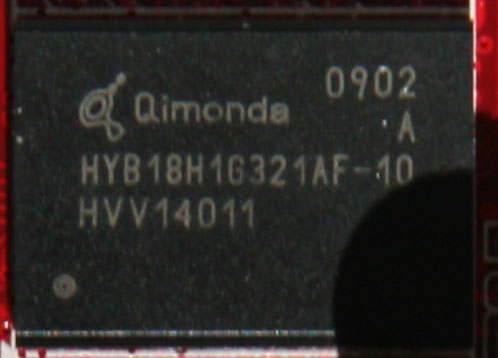
The 4 memory chips on this card are Qimonda HYB18H1G321AF-10. We haven’t been able to find the precise specs for that specific memory chip, but we believe it’s rated for 1000MHz, 100MHz over the operating speed of the card. We’re somewhat curious where Palit is getting these chips though, since Qimonda ceased production 6 months ago amidst bankruptcy. Apparently there’s a stockpile of these things somewhere.
Since it’s a low-power card, the overall design of the GT 220 Sonic Edition is rather simple compared to the complex beasts we see on the high-end. Nothing except the GT216 core itself is cooled, and we know that Palit is using solid OS-CON capacitors.
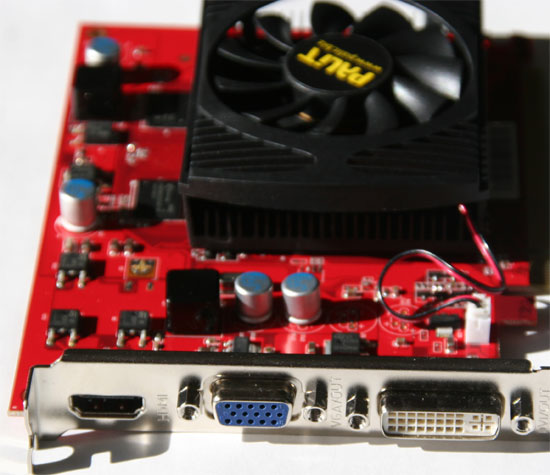
The port layout for this card is 1 HDMI port, 1 VGA port, and 1 DVI port, which appears to be the standard for the GT 220. With one of each port type, Palit’s GT220 Sonic Edition does not come with any port dongles. For that matter, the only other thing you’ll find in the box is a basic manual and driver CD (190.45).
| Form Factor | GT 220 Sonic 512MB | GT 220 1GB DDR3 | GT 220 1GB DDR2 | GT 220 512MB DDR2 |
| Stream Processors | 48 | 48 | 48 | 48 |
| Texture Address / Filtering | 16 / 16 | 16 / 16 | 16 / 16 | 16 / 16 |
| ROPs | 8 | 8 | 8 | 8 |
| Core Clock | 650MHz | 635MHz | 635MHz | 635MHz |
| Shader Clock | 1360MHz | 1360MHz | 1360MHz | 1360MHz |
| Memory Clock | 900MHz | 790MHz | 400MHz |
400MHz |
| Memory Bus Width | 128-bit | 128-bit | 128-bit | 128-bit |
| Frame Buffer | 512MB | 1GB | 1GB | 512MB |
| Transistor Count | 486M | 486M | 486M | 486M |
| Manufacturing Process | TSMC 40nm | TSMC 40nm | TSMC 40nm | TSMC 40nm |
| Price Point | $79 | ? | ? | ? |
Palit will be releasing three other GT 220 cards, in the other configurations that NVIDIA is allowing. These will be two DDR2-equiped cards with 512MB or 1GB of memory running at 400MHz, and a 1GB DDR3 card with its memory running at 790MHz. We don’t have these other cards on-hand, but based on the performance data supplied by Palit, the DDR3 card should be within 10% of the Sonic Edition, and the DDR2 card will be around 60% the speed.
Finally, Palit’s cards should be available from Newegg starting on Tuesday. Palit retreated from the North American market earlier this year to reorganize, so this marks the resumption of their North American retail sales.
The Test
As we mentioned earlier in this article, since NVIDIA is not shipping cards to reviewers, we do not have a traditional stock unit; and this is compounded by the vast array of speeds vendors can and are offering cards. For the purposes of our testing, we are clocking our Palit GT 220 Sonic Edition to 635MHz core, 1360MHz shader, 900MHz memory, and calling that our stock GDDR3 GT 200. The results should be close to where most of the GDDR3 GT 220s end up.
Meanwhile the 9600GSO we’re using is one of the original G92 based models, which means it has 96SPs, and is clocked at 550Mhz/1375MHz/800MHz, with 384MB of GDDR memory, all on a 192-bit bus. This is not to be confused with the poorly named 9600GSO 512, which is 48 shaders at higher clock speeds and a 128bit bus. It’s this latter 9600GSO that the GT 220 is expected to compete with. Unfortunately we were not able to acquire a 9600GT in time for this review, so this is the next-lowest NVIDIA card that we have on hand to use in our comparison.
Finally, the Radeon 4670 we’re using is a 512MB, 1000MHz memory model. They come as low as 800MHz.
| CPU: | Intel Core i7-920 @ 3.33GHz |
| Motherboard: | Intel DX58SO (Intel X58) |
| Chipset Drivers: | Intel 9.1.1.1015 (Intel) |
| Hard Disk: | Intel X25-M SSD (80GB) |
| Memory: | Patriot Viper DDR3-1333 3 x 2GB (7-7-7-20) |
| Video Cards: |
ATI Radeon HD 5870 |
| Video Drivers: |
NVIDIA ForceWare 190.62 |
| OS: | Windows 7 Ultimate 64-bit |
Crysis: Warhead
Kicking things off, we’ll start with Crysis: Warhead. Warhead is still the single most demanding game in our arsenal, with even high-end cards continuing to struggle to put out a playable frame rate with everything turned up.
For testing these low-end cards, we have deviated some from our normal testing. These tests were done with Mainstream graphics quality at resolutions more appropriate for these cards.
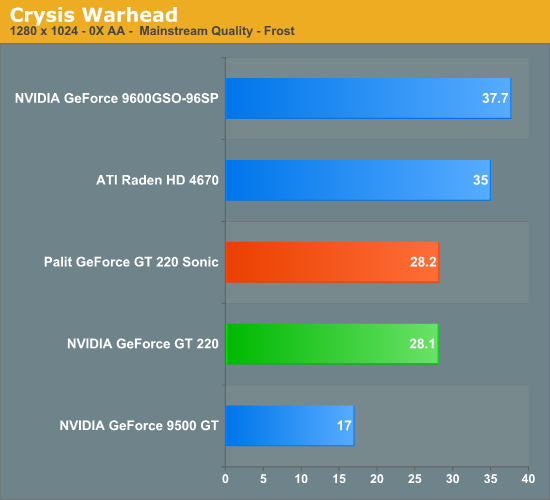
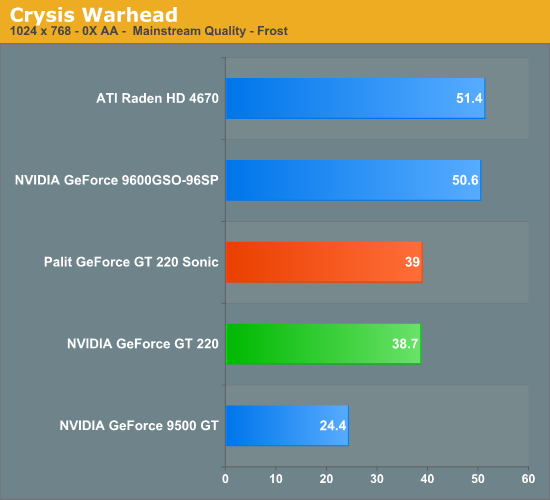
The last card we ended up testing for this article was the 4670, and the moment we ran this benchmark it basically killed any enthusiasm we had for the GT 220. The GT 220 is not competitive here with the 4670, which is its slightly cheaper competition from AMD.
If there is a bright side, Crysis does run decently even on the GT 220 after turning down the quality settings to Mainstream.
Far Cry 2
Far Cry 2 is another foliage-heavy game. Low-end cards can still do decently here, so long as the texture quality isn’t cranked up to the point where it saturates the 512MB and lesser cards.
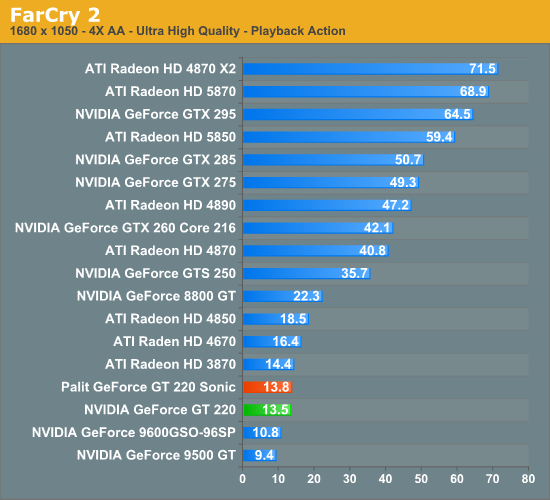
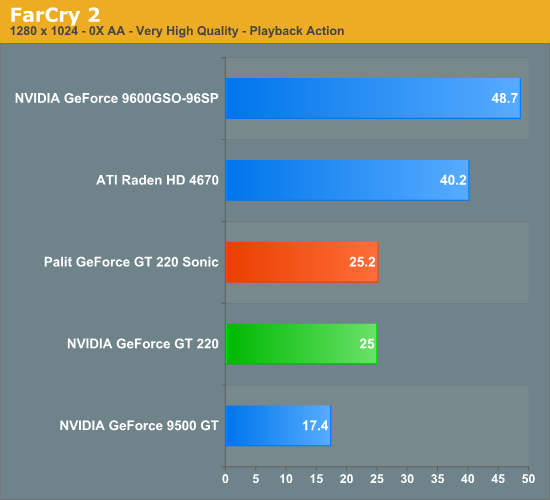
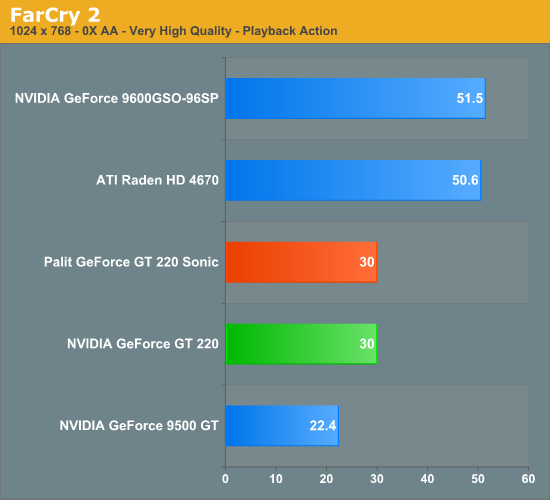
Once again the GT 220 is no match for the 4670. The GT 220 can get playable framerates with these quality settings, but only at 1024x768.
The other pattern we’re going to see here is Palit’s slight factory overclock giving them the smallest of edges over our “stock” GT 220. As Palit is pricing the GT 220 Sonic Edition at $79, it’s going to be faster than any of the stock-speed cards that will be launching at that same price point.
BattleForge
BattleForge is EA’s card-based online-only RTS. As the first DirectX11 title it’s of particular importance for the latest rendition of DirectX, although in this case we aren’t using any features that would be impacted by it. Even without ambient occlusion, BattleForge manages to be a rather punishing game for GPUs.
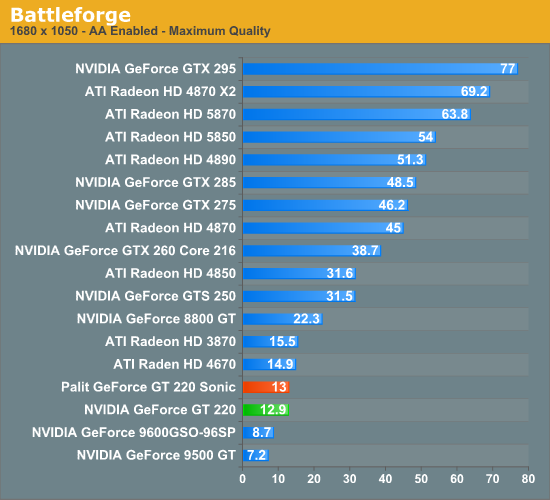
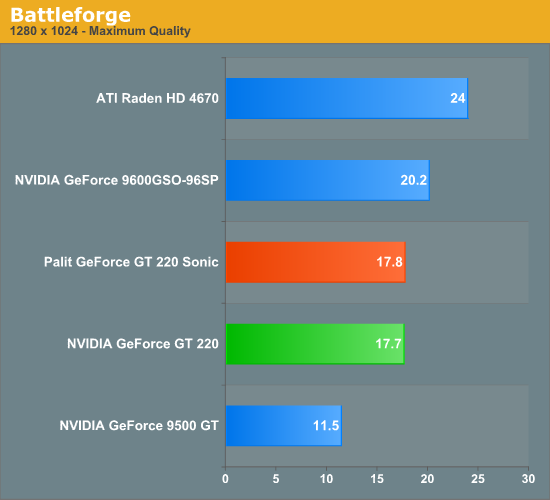
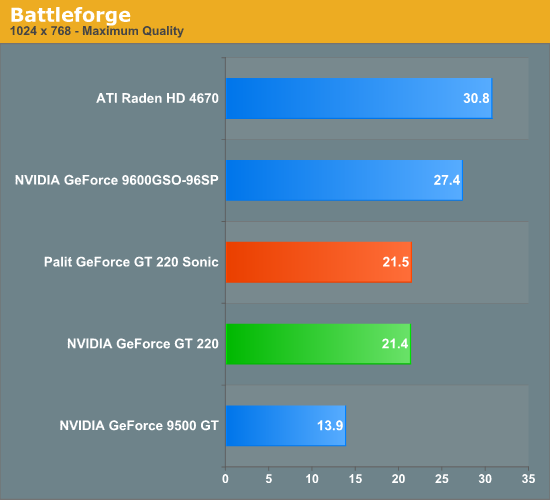
Depending on the resolution, this is one of the worst or one of the best games for the GT 220 as compared to the 4670. The performance gap at 1024x768 is embarrassing, while the gap at 1680 is a more respectable 15%.
HAWX
HAWX is a game that’s not particularly GPU-bound, so even our low-end cards have a fighting chance here.
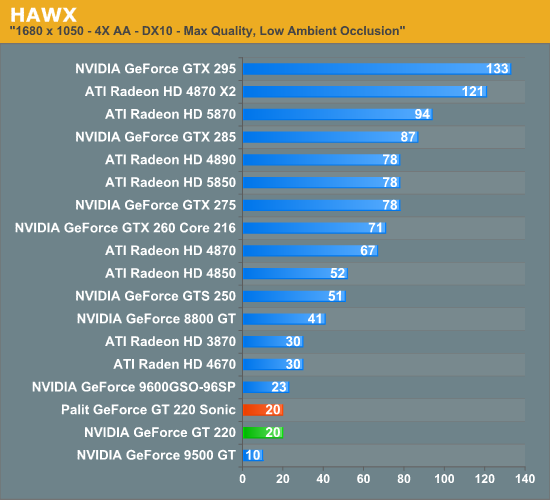
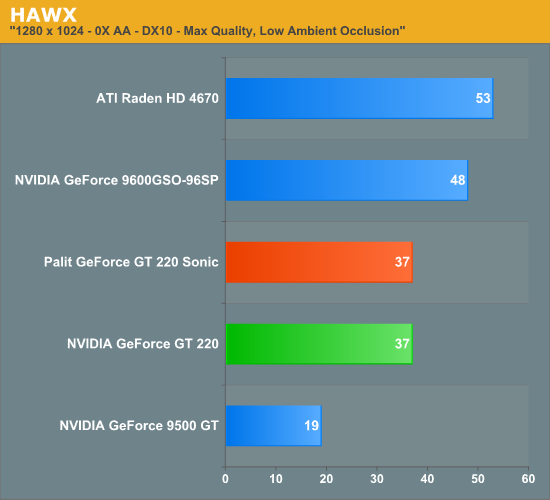

Once more, it’s a story of the GT 220 not being able to keep up. The only thing new here is that we’re seeing the performance gap scale in an opposite manner from Battleforge; the performance gap increases with the resolution instead of decreasing.
Dawn of War II
Dawn of War II is our other RTS benchmark. It’s among the more challenging games in our collection, leading to there being a definite cutoff for playability.
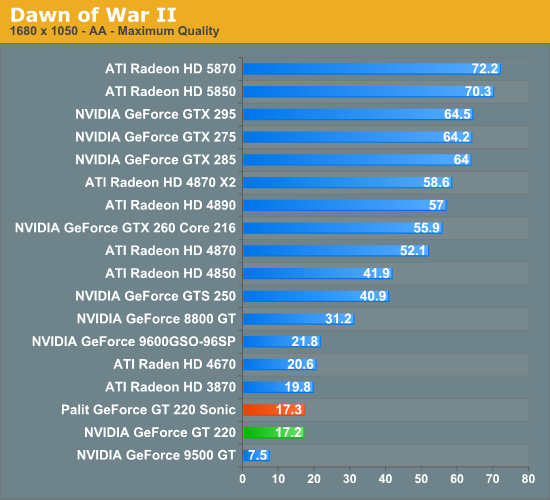
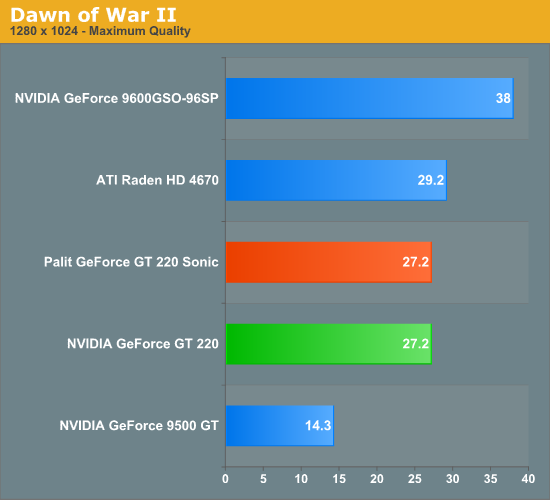
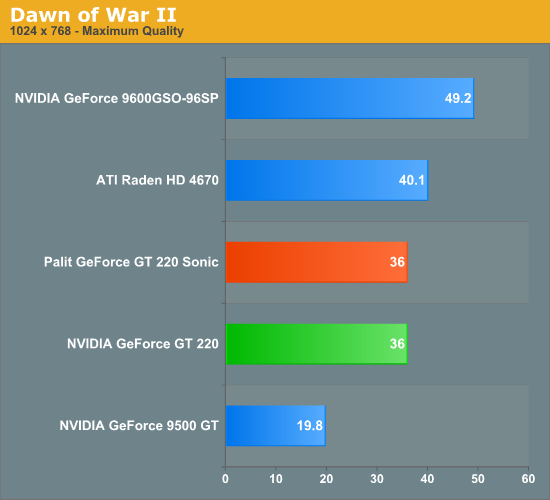
Dawn of War II is one of the GT 220’s better games. It still falls behind, but not by too much. It’s within 10% of the 4670 here.
Resident Evil 5
The latest installment of Capcom’s popular survival horror series just arrived for PCs a few days ago. As is often the case with console ports, it’s not particularly GPU starved
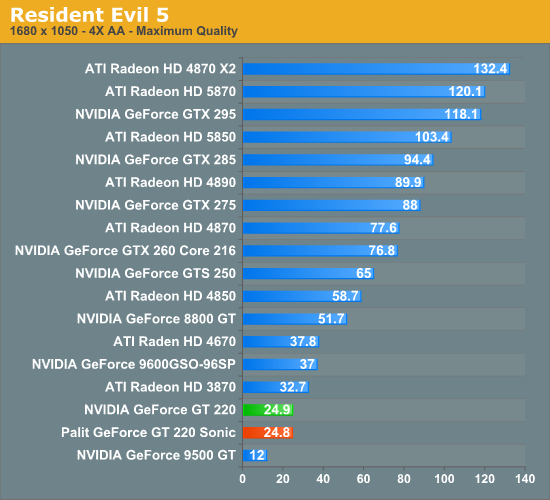
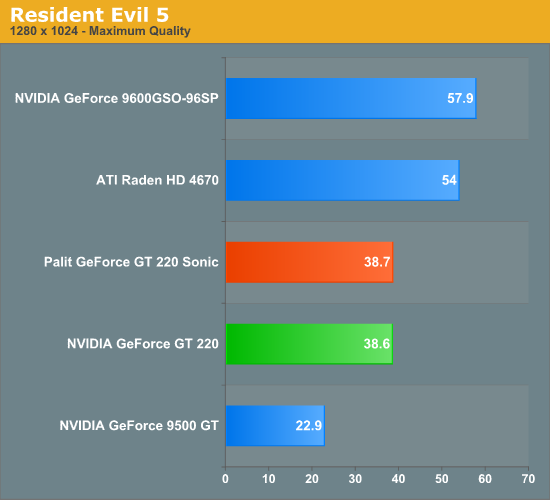
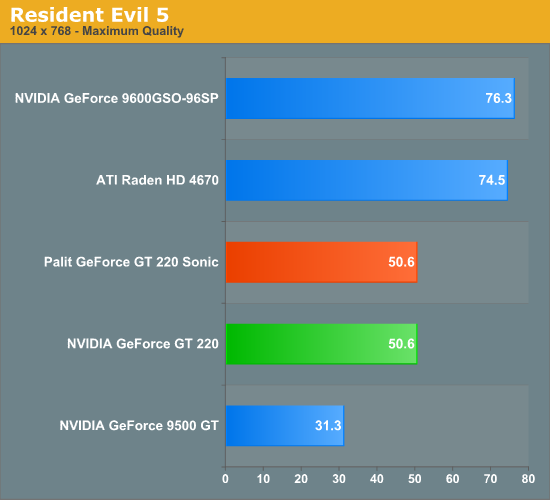
Here is another game where the GT 220 faces an insurmountable gap. The 4670 can get the same frame rate at 1680x1050 with 4x anti-aliasing that the GT 220 gets at 1280x1024 without anti-aliasing.
Batman: Arkham Asylum
Batman: Arkham Asylum is another brand-new PC game, and has been burning up the review charts. It’s an Unreal Engine 3 based game, something that’s not immediately obvious from just looking at it, which is rare for UE3 based games.
As Batman: Arkham Asylum implements anti-aliasing differently between AMD and NVIDIA cards, this is the one title that we do not test AA on, as doing so produces results that can’t be compared.
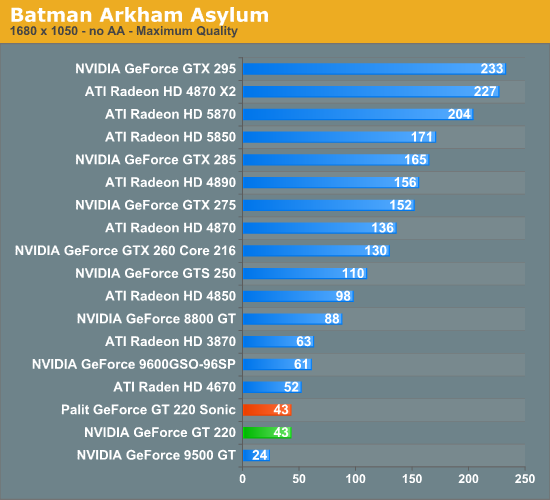
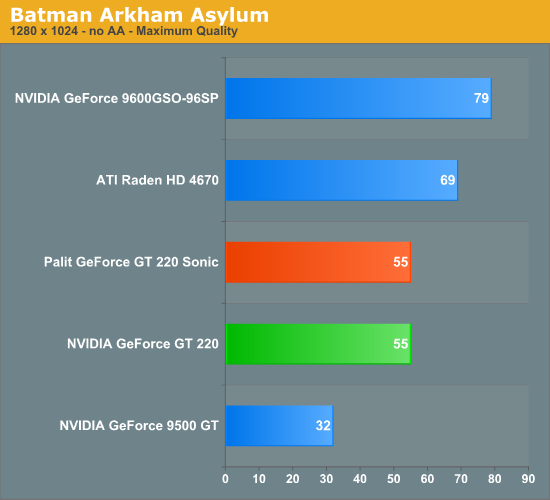
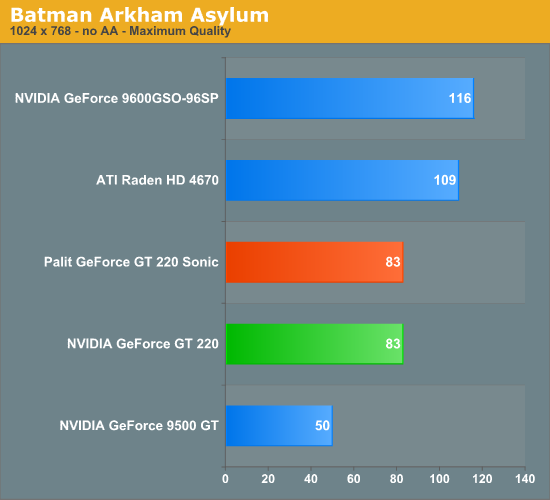
This is one of the best titles all-around for our low-end cards. Everything is playable at 1280x1024 (including the 9500GT), and at 1680 the GT 220 is still above 40fps. But then again, the 4670 is above 50fps in the same situation.
Left 4 Dead
Valve’s venerable Source engine continues to roll on with Left 4 Dead, their co-op zombie shooter. As the Source engine is CPU limited, this is another title that low-end cards can do well at.
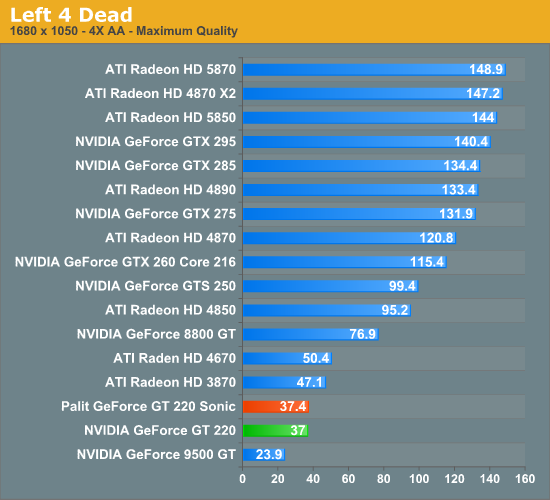
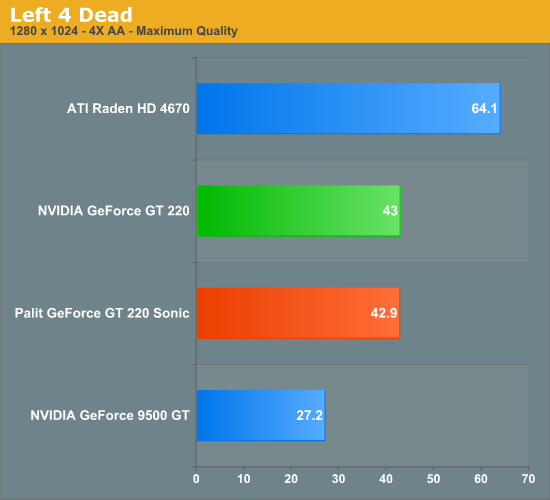
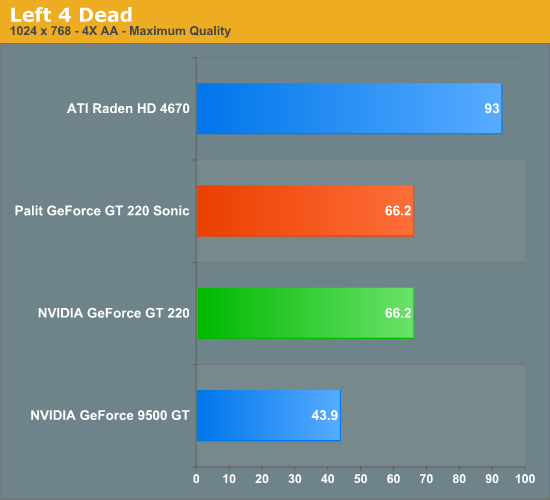
Just to drive home the point of how easy it is to run Left 4 Dead, we left anti-aliasing on for all of these benchmarks. Even with 4x AA, the GT 220 turns in a playable 37fps at 1680x1050. The gap between it and the 4670 remains however.
Temperature & Noise
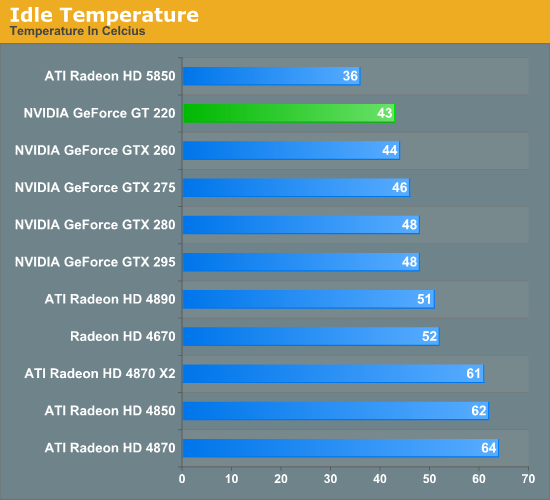
At idle, the GT 220 is one cool card. We’re a bit surprised that it couldn’t beat the 5850 here given the tiny 7W idle power usage, but the 5850 has the advantage of getting to vent hot air out the rear of the card.
Meanwhile we see one of the few chinks in the armor of the Radeon HD 4670. It idles a good 9C higher.
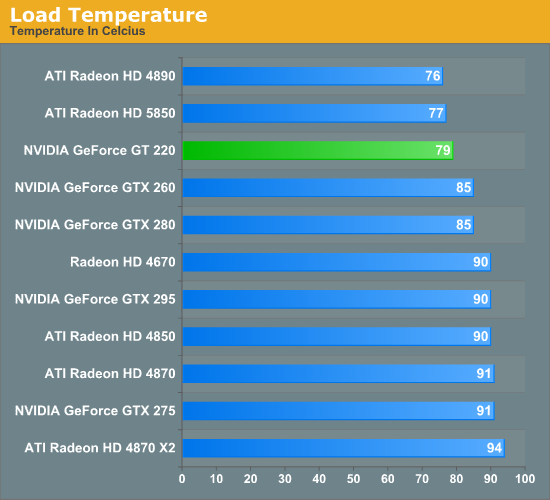
Small cards make little heat. Even with the small cooler on the GT 220, it doesn’t pass 79C. This becomes all the more impressive when we look at the noise data. Meanwhile the 4670 hits 90C. It may be the faster card, but it pays for it here.
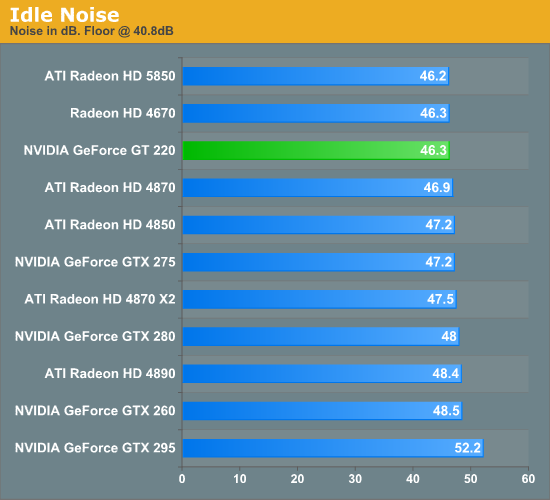
Here we run up against the practical noise floor of our testing rig. Nothing with a fan can get below 46dB.
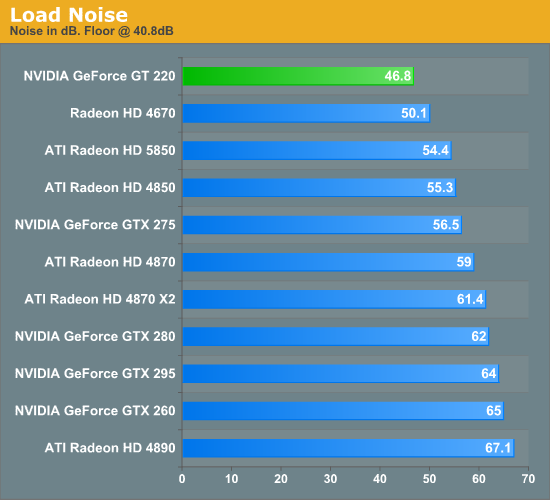
With a fixed speed fan, the GT 220 makes the same amount of noise at idle and at load. This means it’s still running into our noise floor under load even though it’s an actively cooled card. It has all the makings of a good HTPC card, if only the price-to-performance ratio was a bit better.
As for the 4670, it comes in at #2 with 50.1dB under load, making it noisier than the GT 220 but quieter than any of our usual suspects on the high-end.
Conclusion
There’s really no way to sugar-coat this, so we won’t: the performance of the GT 220 is abysmal. Or rather, the pricing is.
The GT 220 is a value card, and that’s something we can appreciate. But for a value card to be a good value, it needs to be at the right price. NVIDIA wants to see these cards sell for $69-$79, with the best cards (those with GDDR3) selling at that $79 price point. However depending on your taste for rebates, we can get a Radeon HD 4670 for between $59 and $69, or on the NVIDIA side a 9600GT for between $69 and $85.
Either one of these cards is simply going to beat the GT 220 silly; it was never meant to compete with a 64SP NVIDIA card, or a 320SP AMD card. And don’t even get us started on the 4850 that Newegg is selling for $85 right now…
Certainly the GT 220 has some positive points. We’re glad to see that NVIDIA has finally ditched the S/PDIF cable and gone internal to enable additional HDMI audio formats, and the ability to finally offload MPEG-4 ASP decoding to the GPU is intriguing. Similarly we’re happy to see DirectX 10.1 support arrive on an NVIDIA part, and the 7W idle power usage on this card is amazing.
But so many of these things are just catching up – AMD had a card that could do DX10.1 and additional HDMI audio formats a year ago. The only thing NVIDIA has going right now is that they’re benefitting from this being a 40nm product, thanks to the lower power usage and lower production costs.
Ultimately we think this has the makings of a very good HTPC card. It’s the quietest actively cooled card we have, it runs cool, and it’s the only thing that can offload MPEG-4 ASP (or at least, will be once support is enabled). But we just can’t justify paying this much more for less performance, especially when there are passively cooled 4670s that can meet/beat the GT 220’s acoustic performance. It’s frustrating to see what’s going to be a very good HTPC card price itself right out of the market.
At the end of the day the GDDR3 GT 220s need to be priced at under $60 to be performance competitive with existing AMD and NVIDIA cards. And the cards with slower memory should be priced even lower (then again, when did memory configurations ever make sense at the low-end?). But at this point such a thing is basically a pipe dream.
As for the Palit GT 220 Sonic Edition that we’re looking at today, Palit really can’t do anything to escape the GT 220’s larger problems. With its slight factory overclock it’s going to be among the fastest GT 220 cards, but it’s a bit like being the king of a desert island. It will get you respect, but it doesn’t mean that very many people are going to want what you have.
This is turning out to be a rough fall for NVIDIA. AMD has them undoubtedly beat in price-to-performance on the high-end of the market. And with today’s launch of the GT 220, it looks like AMD has them beat on the low-end too. There are very few NVIDIA cards that offer the right level of price and performance right now; the GT 220 is not one of those cards.
We’d like to once again thank Palit for providing us with their GT 220 Sonic Edition for today’s launch







